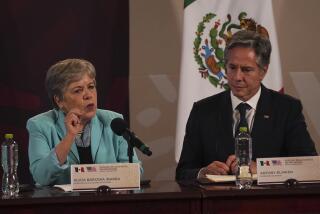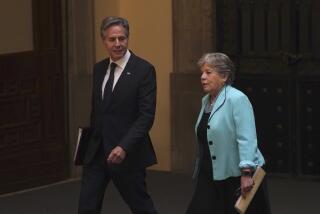Peso-Crisis Loan Earns U.S. a Pretty Penny
- Share via
MEXICO CITY — To Pat Buchanan, it’s a colossal rip-off--a $50-billion Mexican bailout that, he thunders, “you and me and your children and grandchildren” will wind up paying for.
Well, folks--as the folksy Republican presidential candidate might say--you’re in for a surprise. You, me, Buchanan and America’s grandchildren have actually turned a $750-million-plus profit so far on the U.S. government’s controversial loan to Mexico.
“To date, efforts by the United States and the international financial community have been beneficial to both Mexico and the U.S. Treasury,” House Banking Committee Chairman Jim Leach (R-Iowa) said Friday.
Leach, a bailout proponent, issued a report in Washington by the Government Accounting Office, the investigative arm of Congress, on the rescue package. It notes that Mexico has paid hundreds of millions of dollars in interest but warns that the country still faces “difficult challenges” in resuscitating its economy. The Clinton administration and the International Monetary Fund cobbled together the loan package for Mexico in January 1995. A botched government devaluation of the peso had sent the Mexican economy into cardiac arrest, and many feared the panic would paralyze the economies of Latin American and other developing countries, possibly for years.
The U.S. government pledged $20 billion to the $50-billion aid plan--its biggest foreign financial aid commitment since the Marshall Plan.
As the price for the rescue plan, Mexico was forced onto a strict economic diet, with the government slashing spending and hiking interest rates to woo investors back to its beleaguered peso.
So far, Mexico has repaid $2 billion of the money it drew from the U.S. loan, as well as handing over the $750 million in interest. It still owes $10.5 billion.
“Even the [U.S.] Treasury is making money on this debt. It was lent on commercial terms,” said Alejandro Valenzuela, spokesman for the Mexican Treasury.
In fact, U.S. and IMF officials say interest rates on the U.S. loan were intentionally set high--up to 10.16%--to encourage Mexico to repay as soon as possible and to replace that borrowing with private debt.
That has already started to happen. Last month, Mexico repaid part of the U.S. loan by selling bonds to German investors.
Mexico has begun to see signs of recovery. As the peso has lost value, its exports have jumped and imports tumbled, generating large trade surpluses that have given Mexico access to dollars it can use for repayment.
But Mexico is still far from out of the woods. Its recovery is still wobbly, threatened especially by the precarious condition of the country’s banks. And most of its U.S. debt falls due in the final years of this century.
In its report, the GAO said that “it remains to be seen whether Mexico will be able to maintain economic policies that will allow the economy to recover from the crisis.”
Independent economist Rogelio Ramirez de la O noted that Mexico’s export boom has occurred even as the domestic economy withered by 7% last year.
“How do you generate a [trade] surplus? By consuming less,” he said. “Mexicans have been tightening their belts. But will they continue to tighten their belts to maintain the export boom?”
Although U.S. taxpayers have made a profit of sorts, they shouldn’t expect a check in the mail. According to U.S. Treasury officials, the $750 million in interest will go back into the Exchange Stabilization Fund--a pot of money used to keep the U.S. exchange rate stable.
More to Read
Sign up for Essential California
The most important California stories and recommendations in your inbox every morning.
You may occasionally receive promotional content from the Los Angeles Times.












